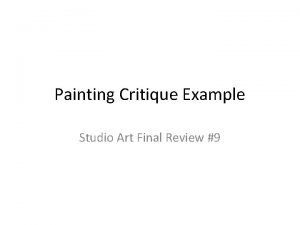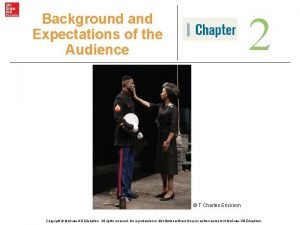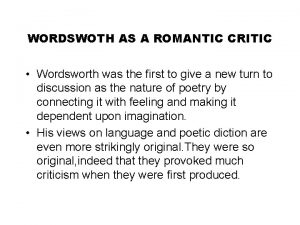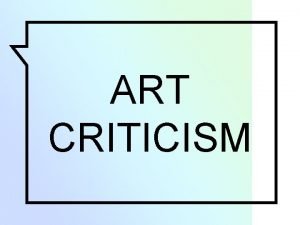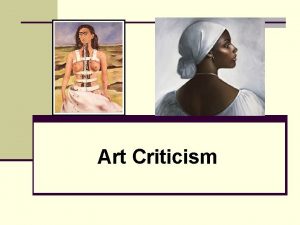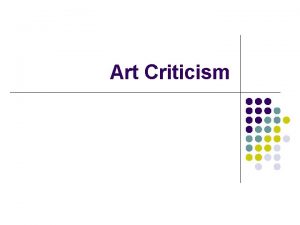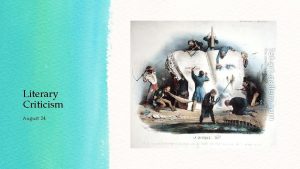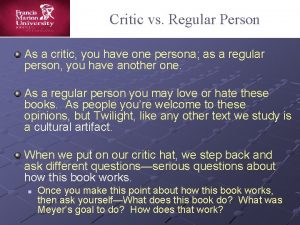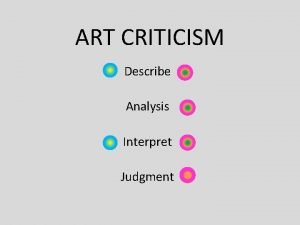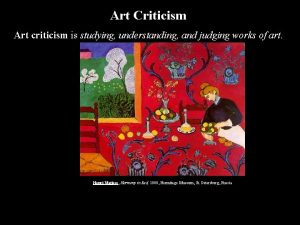Art Criticism What is an art critic l












- Slides: 12

Art Criticism

What is an art critic? l l What do you think of when you think of a critic? Do you think of someone who is mean and finds everything they can wrong with an artwork?

Anyone can be an art critic! l l l Art criticism is the process of evaluating artworks. The process does not have to be negative. In art criticism you follow four steps to make a judgment about an artworks success.

Why art criticism? l l l Art criticism allows you to judge an artwork more objectively. This allows you to make a judgment that is based on factual information instead of simply opinion. Making judgments based on fact instead of opinion is much stronger and more thorough way of looking at artworks. ?

When do I use art criticism? l l l Art criticism is appropriate to use whenever you are asked to judge an artwork. With a few changes it could also be used to judge music, literature or drama. The process prepares you for making other judgments such as decisions about major purchases such as cars and homes. The more you practice making a educated informed judgment, the easier it will be for you to make important decisions!

Four Steps to Art Criticism l l Step One- Describing Step Two- Analyzing Step Three- Interpreting Step Four- Judging Click on any of the links above to jump directly to that step or just advance the slide show to go through each step individually!

Step 1 - Describing In the first step you give a description of the artwork. You explainl Size, Medium, and Process (found in credit line of artwork!) l Subject and Objects in the artwork (tell what you see) l 3 Elements of Art (be sure to explain how the artist used them! For a reminder of the seven elements of art, use the following link to Mrs. England’s website to view an element of art Power. Point! http: //www. barren. kyschools. us/userfiles/1257/Classes/924/Element s%20 of%20 Art%208. ppt Back to Steps!

Step 2 - Analyzing In this step you explain how the artist organized the artwork (the composition. ) Choose three principles of design and be sure to explain how the artist used them with the elements of art!! For a reminder of some of the principles of design follow the link below to Mrs. England’s webpage for a Power. Point on the principles of design! http: //www. barren. kyschools. us/userfiles/1257/Classes /924/Principles%20 of%20 Design. ppt Back to Steps

Step 3 - Interpreting In this step you explain the mood or meaning of an artwork. Be sure to explain and justify your answer, don’t just put “the artwork looks sad”! Back to Steps

Step 4 - Judging In the final step you make a judgment of whether or not the artwork is successful based on one of three aesthetic viewsl View #1 - Subject- The artwork is successful only if it is realistic. l View #2 - Content- The artwork is successful if it creates a strong mood or feeling. l View #3 - Composition- The artwork is successful if the artist successfully used the elements and principles together to make a good composition. Remember you only pick one view and you justify you answer!! Back to Steps

Now you try! Use the artwork on the next slide to complete the four step art criticism process!! For even more practice follow the link below to Mark Harden’s Artchive website, choose your favorite artist and artwork and try it out! http: //www. artchive. com/ftp_site. htm

Credit Line. George Caleb Bingham, Fur Traders Descending the Missouri, 1845, oil on canvas, 29 x 36 1/2 “, Metropolitan Museum of Art, New York
 Sculpture critique example
Sculpture critique example Feldman theory of art criticism
Feldman theory of art criticism Difference between formalism and new criticism
Difference between formalism and new criticism Descriptive criticism vs prescriptive criticism
Descriptive criticism vs prescriptive criticism Bible verses about constructive criticism
Bible verses about constructive criticism The difference between criticism and constructive criticism
The difference between criticism and constructive criticism New deal critic dr francis townsend
New deal critic dr francis townsend Preface to the fables summary
Preface to the fables summary By listening to my inner defender voice i can be sure that
By listening to my inner defender voice i can be sure that Ron weasley outline
Ron weasley outline William wordsworth as a romantic critic
William wordsworth as a romantic critic Lightweight markup language
Lightweight markup language Longinus on the sublime ppt
Longinus on the sublime ppt
